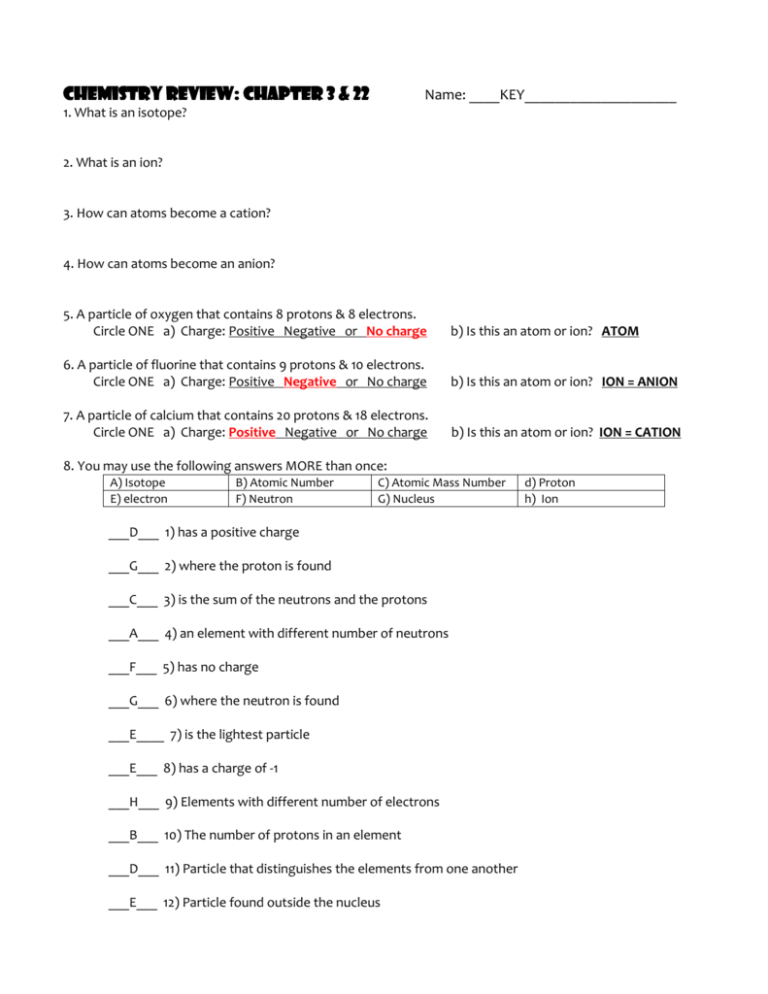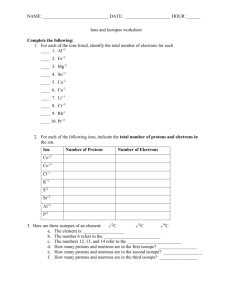Isotopes, Ions Worksheet
advertisement

Chemistry REVIEW: Chapter 3 & 22 Name: ____KEY____________________ 1. What is an isotope? 2. What is an ion? 3. How can atoms become a cation? 4. How can atoms become an anion? 5. A particle of oxygen that contains 8 protons & 8 electrons. Circle ONE a) Charge: Positive Negative or No charge b) Is this an atom or ion? ATOM 6. A particle of fluorine that contains 9 protons & 10 electrons. Circle ONE a) Charge: Positive Negative or No charge b) Is this an atom or ion? ION = ANION 7. A particle of calcium that contains 20 protons & 18 electrons. Circle ONE a) Charge: Positive Negative or No charge b) Is this an atom or ion? ION = CATION 8. You may use the following answers MORE than once: A) Isotope E) electron B) Atomic Number F) Neutron C) Atomic Mass Number G) Nucleus ___D___ 1) has a positive charge ___G___ 2) where the proton is found ___C___ 3) is the sum of the neutrons and the protons ___A___ 4) an element with different number of neutrons ___F___ 5) has no charge ___G___ 6) where the neutron is found ___E____ 7) is the lightest particle ___E___ 8) has a charge of -1 ___H___ 9) Elements with different number of electrons ___B___ 10) The number of protons in an element ___D___ 11) Particle that distinguishes the elements from one another ___E___ 12) Particle found outside the nucleus d) Proton h) Ion 91 9. Give the number of protons, neutrons and electrons in 40Zr +4 ion Protons: ___40_____ Neutrons: ____51_____ Electrons: ____36______ 10. Complete the following table Hyphen Notation the atom that contains 10 protons and 11 neutrons Ne-21 the ion that contains 16 protons, 17 neutrons and 18 electrons S-33 -2 the ion that contains 56 protons, 54 electrons and has a mass# of 141 Nuclear Notation Ba-141 +2 11. Compare the density and charge of the nucleus and the electron cloud. Nucleus has a POSITIVE charge & is extremely dense. Electron cloud has NEGATIVE charge & is mostly space 12. What is “average atomic mass”? 13. The mass of element X has a 78.99% abundance for isotope 23.9850, 10.00% for isotope 24.9858 and 11.01% for isotope 25.9826. a) What is the atomic mass of the element? __24.305_________ (Hint: Calculation is based on a weighted average.) b) What element is it? ___MAGNESIUM__________ 14. How many atoms are there in 2.50 mol of Hydrogen? 1.51 x 10 24 atoms Hydrogen 15. How many moles are present in 107 g of sodium? 4.65 moles Na 16. How many atoms are in 80.45g of magnesium? 1.99 x 10 24 atoms Mg 17. Be sure you understand the following concepts before the test: Law of Conservation of Mass Law of Definite Proportions Law of Multiple Proportions Chapter 22 REVIEW 18. Radiation is an unstable nucleus that spits out particles from the _NUCLEUS_______. 19. What cause the nucleus to be unstable? _______________________________. 20. a) Do different atoms of the same element have different half-life (t ½ )? NO Different atoms of the same element have the SAME half-life. b) Do different isotopes have different half-lifes (t ½ )? YES Different isotopes have a different neutron number which results in different half-life 21. List THREE Nuclear Applications 1. _______________________ 2. ______________________ 3. _______________________ 22. Why is it important to know the “mass defect” number? Missing mass is converted into energy. Nuclear power plants create only enough energy to produce electricity. (Too much energy would result in atomic bombs.) 23. Explain the difference between Nuclear Fusion and Nuclear Fission and give an example of each. 24. Write balanced nuclear equations for the following transformations. a. neodymium-141 undergoes electron capture Pr-141 b. selenium-81 undergoes beta decay Br-81 c. strontium-83 decays by positron emission Rb-37 25. What particle is produced during the following decay processes? (Alpha, Beta, Gamma, etc). a. Na-24 to Mg-24 ________________________________ BETA b. Hg-188 to Au-188 ________________________________ POSITRON c. I-122 to Xe-122 ________________________________ BETA d. Pu-242 to U-238 ________________________________ ALPHA 26. Complete and balance the following nuclear equations by supplying the missing particle. a. 252Cf + 10B 1 3 0n + ______ c. 59Fe β + _______ f. 88Sr + 84Kr 116Pd + _______ b. 122I 122Xe + _______ d. 233U 1 + 0n 133Sb + d. 40Ca + 238U 70Zn 98Nb 1 + _______ 0n 1 + 4 0n + 2 _______ 27. A radioactive decay series that begins with Th-232 ends with the formation of the stable nuclide Pb-208. How many alpha-particle emissions and how many beta-particle emissions are involved in the sequence of radioactive decays? alpha = __6____ beta = __4___ 28. The half-life of tritium (hydrogen-3) is 12.3 years. Suppose 48.0mg of tritium is released from a nuclear power plant during the course of an accident. a. What mass of this nuclide will remain after 12.3 years? 24 mg b. What mass will remain after 49.2 years? 3 mg 29. It takes 5.2 minutes for a 1.000g sample of 210Fr to decay to 0.250g. What is the half-life of 210Fr? 2.6 min 30. Cobalt-60 has a half-life of 5.26 years. The Co-60 in a radiotherapy unit must be replaced when its radioactivity falls to 75% decay. If the original sample was purchased in August 2007, when will it be necessary to replace the Co-60? T = 10.52 year Aug 2007 + 10.52 yrs = February 2018








